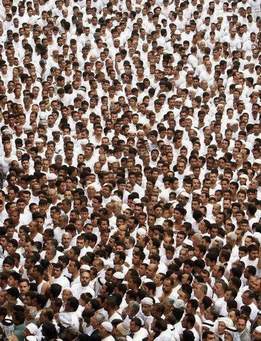|
Mother Theresa gave her life to wanting the unwanted. In caring for the poorest of the poor, she was remembering something that had been forgotten: people. She went to the gutters and the garbage heaps, two places where humanity itself had been thrown away and left to rot, and there she set to work patiently and tenderly restoring to people the dignity of being human. We will never be motivated to do this until we see the image of God in people. If Mother Teresa could do this for people whose toes and fingers were nibbled by rats and whose living flesh crawled with maggots, then can you and I not do the same for the healthy and attractive people who are our friends and neighbors? Can we not make it our goal to give some dignity to everyone we meet, to encounter others in the way that leaves them actually feeling more human, more loved?
We will never be motivated to do this until we see the image of God in people. All of Mother Teresa’s days began with prayer, and after meeting God in prayer she went out into the streets of Calcutta to meet Him there in the form of people. The people she cared for were Christ to her. She took with absolute literalness Jesus’ words ”Whatever you did for the least of these brothers of mine, you did for me” (Matthew 25:40). During the 1980s the paintings of Michelangelo in the Sistine Chapel underwent restoration. Centuries of accumulated soot and grime was removed, revealing astonishingly vivid colors underneath. A panoply of figures that the world had not seen as being smudged and dark were suddenly filled with light. What was done in Rome for painted images, Mother Teresa did in Calcutta for living souls. Her primary goal was not to better the lot of the poor, not to alleviate the suffering of the sick, not even to save lives. Rather, her goal was to recover the image of God in people. For this work her primary tool was not food, clothing, money, or orphanages, but God’s love.” It’s not how much you do that counts,” she said,” but how much love is in what you do” She went to the very poorest people because these were the ones to whom God had called her. WHO ARE YOUR PEOPLE ? Who is calling out for your love? Perhaps it is the comfortable middle-class people in your own neighborhood or family. In Mother Theresa’s eyes it was not a better thing to serve the poor than the rich. She was merely following her vocation.” A vocation cannot be forced,” she said. “It comes from above.” In the eyes of the rich, Mother Teresa saw the same loneliness, the same poverty, the same desperation as in the poor. “The world is suffering much,” she said” because of this terrible disease – not of leprosy, not of tuberculosis, not even of hunger – but of that feeling of wanting to be wanted, to be loved, to be somebody to somebody.” Not only in the streets of Calcutta, but in North America, too, Mother Teresa saw faces filled with pain, disease, abandonment, abject poverty. Jesus said the same: “You do not realize that you are wretched, pitiful, poor, blind and naked.” Since the rich have the same basic needs as the poor, they require the same treatment. They do need to be touched, to be smiled at, to be taken into someone’s heart, to feel the purity of love. The self-reliant and the strong, perhaps even more than the weak, need to be somebody to somebody. Who is prepared to work at restoring true dignity to these gray and careworn faces, these puffy, overweight bodies, these frantic and frightened lives? The light of God is a lamp whose fuel is human flesh. The flame is within; it matters not how the flesh looks on the outside. Mother Theresa looked past the present, surface appearance of people to see into their past and future. She saw their beautiful, innocent past in the Garden of Eden, and she saw their glorious potential as the children of God in heaven. Seeing the light of God’s image deep down inside of human beings, she devoted herself to lovingly cleaning away the smudge and the grime of poverty and neglect so that the true light could shine. Sure enough as she gently touched the destitute and the dying and cleaned their wounds and actual light seemed to glow in them. Many who have visited her houses of charity have spoken of the otherworldly radiance in these dim, ugly, unlikely places. Can the presence of God be seen and felt? Yes, there is a light and warmth where true love is present. It is the light of Christ, as spoken of in the first chapter of John:” In him was life, and that life was the light of men. The light shines in the darkness, but the darkness has not understood it” (vv.4-5). God can be seen. But do we have eyes to see? Sometimes in the woods I’ll see a wildflower, perhaps one that has just blossomed that morning, and I’ll think: no one has ever laid eyes on this flower before. A strange purity dwells where human eyes have never touched. In the same way, are there not millions of people in the world whom no one has ever seen, whom no eyes have ever touched with deep, pure love? Perhaps we do not need to do anything else for these people except to see them, to notice them. If only we would open our eyes, our hearts too would open like flowers and the perfume of good deeds would flow. Chapter 12 from PRACTICE THE PRESENCE OF PEOPLE by Mike Mason-
1 Comment
|
Details
AuthorTrying to follow the Lord's will regarding ministry and the platform of golf. Archives
January 2023
Categories |
Copyright © 2021


 RSS Feed
RSS Feed
